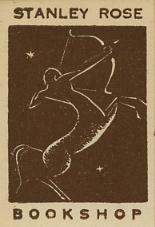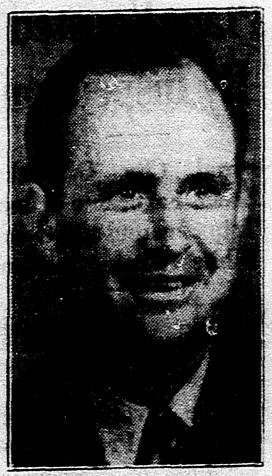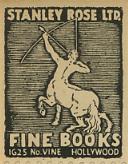Stanley Rose
born Matador, Texas, December 5, 1899 --- died Los Angeles, California, October 17, 1954
 |
 |
 |
Stanley Rose
born Matador, Texas, December 5, 1899 --- died Los Angeles, California, October 17, 1954
 |
 |
 |
Stanley Rose -- bookseller, literary agent and raconteur -- was a legendary character in L.A./Hollywood book circles. His bookshop/art gallery (located first on Vine Street, then later on Hollywood Boulevard next door to the Musso & Frank restaurant) was a gathering place during much of the 1930s for the polyglot literati of the movie industry -- which is to say: screenwriters, and novelists slumming as such while passing through Hollywood (sometimes permanently). Kevin Starr has written: "The bookshop and the bar [at Musso & Frank] operated together with superb synergy, creating a welcomed sense of community for screenwriters suffering from an understandable sense of displacement." Budd Schulberg, author of What Makes Sammy Run?, recalled that "the nearest thing we had to a salon (and also a saloon) was Stanley Rose's Book Shop, the back room of which was a hangout for writers, would-be-writers, had-been-writers." Musso & Frank's also had a "back room" -- known in some accounts as "the Writers' Room" -- and the town's literary denizens flowed so freely between the two locations that in Hollywood legend they have come to be spoken of as though they were one and the same. Although "the boys in the back room" was hardly a new phrase when critic Edmund Wilson appropriated it for the title of his 1941 book The Boys in the Back Room: Notes on California Novelists, his usage has probably been most responsible for the phrase's association with the entire school of Hollywood-centered, variously hard-boiled and/or minimalist writers of the 1930s and 1940s. (Wilson discussed just six individual writers: James M. Cain, John O'Hara, John Steinbeck, Hans Otto Storm, William Saroyan and F. Scott Fitzgerald, with an additional nod to Nathanael West in the book's postscript, and passing mentions of several others.)
[The Kevin Starr quote above, by the way, comes from Chapter 7 of his book Material Dreams: Southern California Through the 1920s, which is an excellent starting point for anyone interested in learning about the importance of books and bookmen in the cultural life of Los Angeles during the boom years of the 1920s and 1930s.]
(The geography of the "back rooms" of the bookshop and the restaurant is an interesting topic, about which much misinformation has been published over the years. I am still nailing down the facts to a degree of precision -- an effort supported by the current management of Musso & Frank -- and the next time I revise this page, I will go into some detail. Suffice it to say for the moment that two ideas that have made it into print over the years -- (1) that the restaurant expanded into the space formerly occupied by the bookshop; and (2) that this expansion was actually the impetus for the closing of the bookshop -- are untrue.)
As noted above, Stanley Rose is a legendary figure. There are numerous references to him in the literature pertaining to that time and place -- he figures, at least anecdotally, in many writers' biographies (especially William Saroyan, to whom he was not only a good friend but also a literary agent, and Nathanael West, who I've seen described as Rose's "best friend" among the shop's writer-patrons) -- but as usual with "legendary" characters, the anecdotal accounts are sometimes contradictory, and the facts can be a little hard to pin down. As part of my effort to sort out fact from legend, I've put together a Wikipedia page about Stanley's life and his significance in Hollywood/L.A. book culture, which can be seen here: http://en.wikipedia.org/wiki/Stanley_Rose. This is hardly definitive, and it's hampered by Wikipedia's insistence on the use of published (and thus putatively "authoritative") sources, but at least it serves the purpose of getting the basic story out there for the edification of anyone who's interested.
I had written in this space previously about being in search of a photograph of the Stanley Rose Book Shop. My search ended (well, not really) with the publication of Jim Heimann and Kevin Starr's marvelous book Los Angeles: Portrait of a City by Taschen in 2009. There is an amazing high-angle photo of the interior of the shop, taken by noted photographer John Swope circa 1935, which the authors wisely chose to reproduce as a full-page image (about 10" x 13"). Absent the appropriate permission from the Swope estate, I will not reproduce it here, but I highly recommend that you run this book down and check it out for yourself. (In fact, if you care about the history of L.A. at all, you should own this book, period, no discussion.) One of the best things about this photo is that Stanley Rose himself is in it, standing the middle of his domain, chatting with none other than author Jim Tully, one of the store's regulars (and one of Stanley's drinking buddies). Aside from that astounding photo, the only related images I've seen are a couple of extreme long views of that section of Hollywood Boulevard, in which can be seen his rooftop sign (or, in one photo, just part of it); somewhere out there must be a good view of the exterior of the shop.
More to come; this page is a work in progress. For now, however, I'll just leave you with this little bit of StanleyRoseiana:
- Writer: "Then how come you run a bookstore?"
- Rose: "'Cause I like to keep a joint where my pals c'n hang out."
- -- reported by Budd Schulberg in The Four Seasons of Success (Doubleday, 1972)